Menu
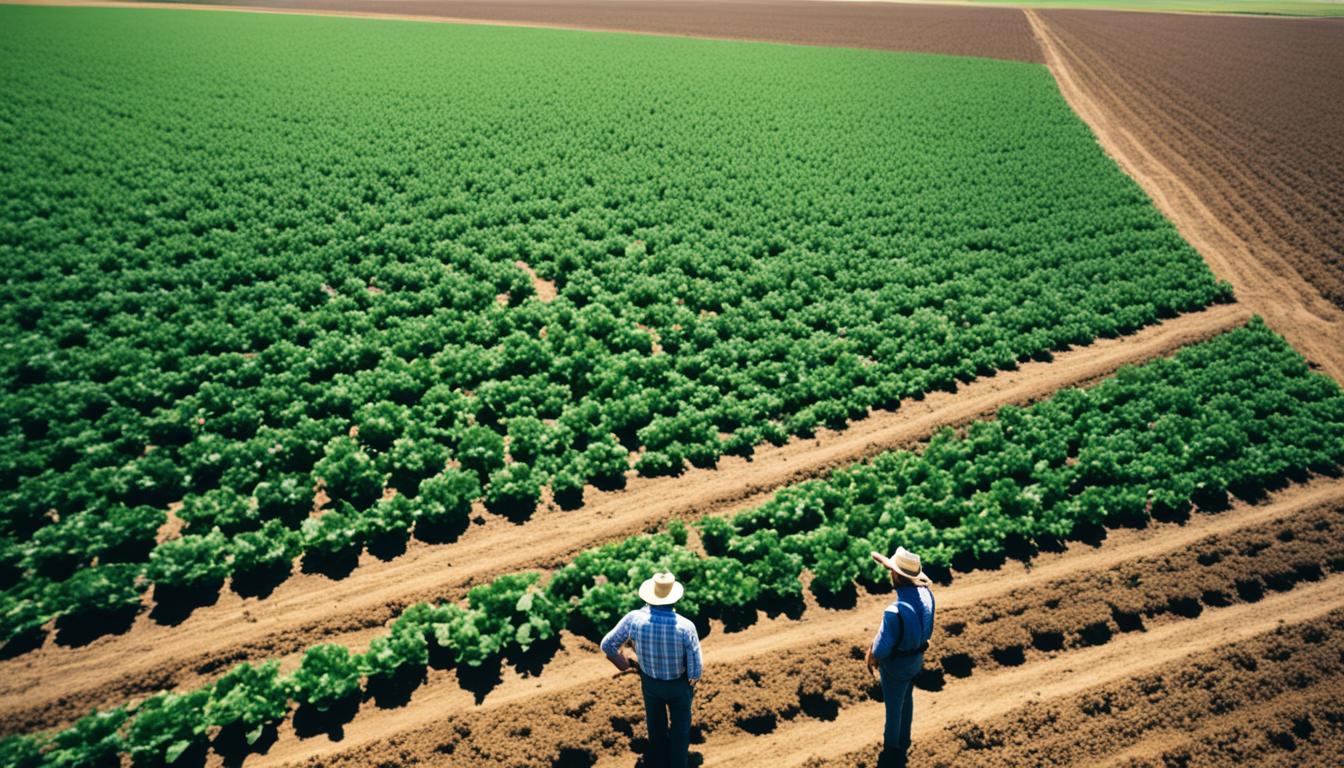
About 75% of the Earth’s farming soils face limits from soil moisture. This is true especially in regions with little rain. This shows how crucial it is to manage soil moisture well. Doing so helps in conserving water and farming sustainably.
In places with not much rain, managing soil moisture properly is even more important. This can be the difference between a good harvest and a bad one. To do well in farming, especially without irrigation, capturing rainwater efficiently is key.
You should also try to keep the moisture in the soil where plants can reach it. This means you need to know about the water cycle, how water soaks into the ground, and avoid water running off or evaporating too quickly. You also want to make sure the soil holds as much water as possible.
To manage soil moisture, there are low-cost techniques like using compost, mulching, not ploughing the fields too much, changing what you grow in different fields each year, and planting special crops to add nutrients back to the soil. These methods don’t just save water. They also make the soil better, increase food for the plants, and mean you don’t have to water as much by hand. In the end, using these tricks can make your crops better and save money on water.
Soil moisture is key for healthy crops and good farm output. About three-quarters of the world’s farmable land see crop growth limited by lack of water. This is a big problem in areas with tropical and subtropical weather, where there’s heavy dependence on rain.
The places where this issue hits hard get between 400 to 1000 mm of rain each year. Unfortunately, this rain doesn’t always come when it’s needed. That makes growing crops a real challenge.
Good soil moisture is vital for plant growth. More water in the soil means healthier plants and bigger harvests.
When water is spread evenly through the soil, plants can use it better. This makes their roots grow stronger. Different soils hold different amounts of water. Knowing how much water your soil can hold helps plants get what they need.
It’s important to check soil moisture to keep crops healthy.
The right soil moisture levels are critical for farming success. Little water in the soil can lead to lower harvests or even crop failure. On the other hand, managing water well can boost the amount of crops grown.
By using proper techniques, farmers can make the most of rain and water their fields smartly. This isn’t just good for now. It helps keep the soil healthy over the long run.
Testing soil moisture with tools like tensiometers can make water use more efficient. This, in turn, increases the amount of crops you can grow. These tests help in planning when and how much to water crops.
Realising how important soil moisture is, and using smart tools to keep track of it, boosts farm yields. This is key for farming that lasts and helps the earth.
Understanding soil water movement helps manage soil moisture well. Elements like infiltration, permeability, soil type, and structure are key. They guide how water moves in the soil. Good water movement ensures plant roots get enough moisture. This supports strong plant growth and higher farm yields.
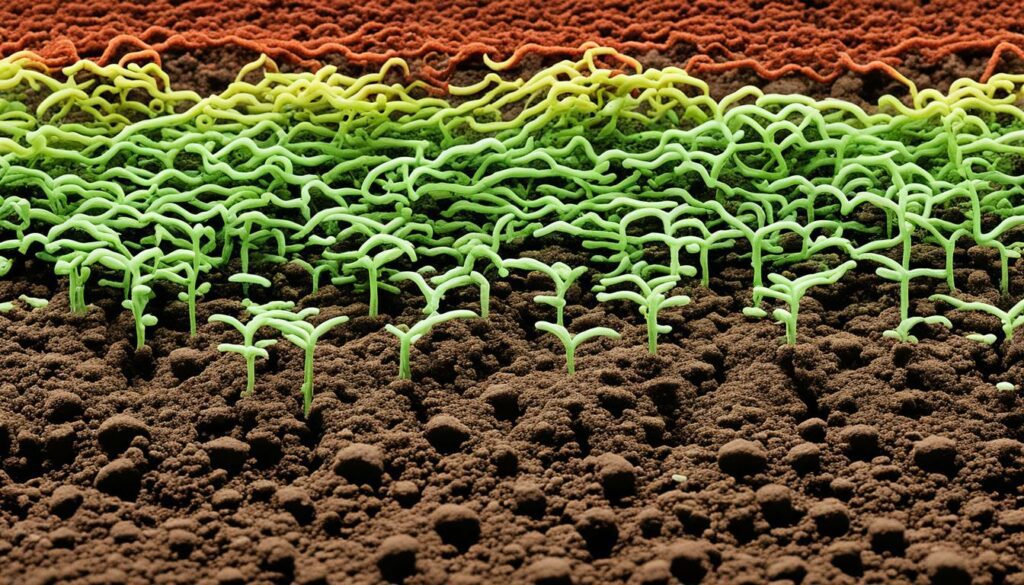
Infiltration is how water gets into the soil, mainly through its top layers. Permeability is how fast water moves down through the soil. Both are affected by how we farm, like tilling and keeping the soil healthy. Over-tilling and losing natural matter slow down water getting in the soil. So, keeping the soil’s natural health and structure helps water move better. Tools like tensiometers and the WATERMARK 200SS help test soil water levels. They give important information for managing water movement in the soil.
The soil’s type, such as clay, loam, or sand, affects how it holds and moves water. For example, soils with more clay can hold water better than sandy ones. Different soils need different amounts of force to move water. The soil structure, which is how soil particles are arranged, also affects how water moves. Examples are how some soils can let water move through quickly, while others are slower. Adding organic matter can make soil better at holding and moving water. This is important for dry or wet farming. It shows the need to balance how water enters and moves in the soil for good farm practices and water use.
| Soil Type | Water Holding Capacity | Permeability | Suitable for |
|---|---|---|---|
| Clay Loam | High | Slow | Dryland Farming |
| Loam | Moderate | Moderate | General Agriculture |
| Sandy Loam | Low | Fast | Irrigated Systems |
Looking after soil health and structure is key in moving water well in the soil. With good farming and adding natural matter, water movement improves. This is good for using water wisely and for keeping farms healthy.
It’s vital to know the various factors that impact soil moisture. These include climate, the type of soil, and how deep plant roots go. We will dive into these aspects.
Changes in the weather and how much rain falls are key. Places with changing rain or little rainfall find it hard to keep the soil moist enough. In these areas, it’s important to use methods that save water for the plants.
The kind of soil you have affects its water-holding ability. Different soils, like clay or sandy soil, can hold different amounts of water. They also take in and keep water in unique ways. This is why it’s crucial to manage the water in the soil well.
How deep plant roots go impacts how they get water from the soil. Plants with roots that reach deep can find water in lower soil levels. This helps them survive when the top layer is dry. For plants with shallow roots, they need more water added or regular rain to grow well.
Understanding these factors helps us better take care of soil moisture. It’s crucial for farming sustainably and dealing with the changes in our climate.
Soil moisture conservation is key for keeping water and sustainable farming. It stops water from evaporating and transpiring. This keeps crops hydrated, especially in places with little water.
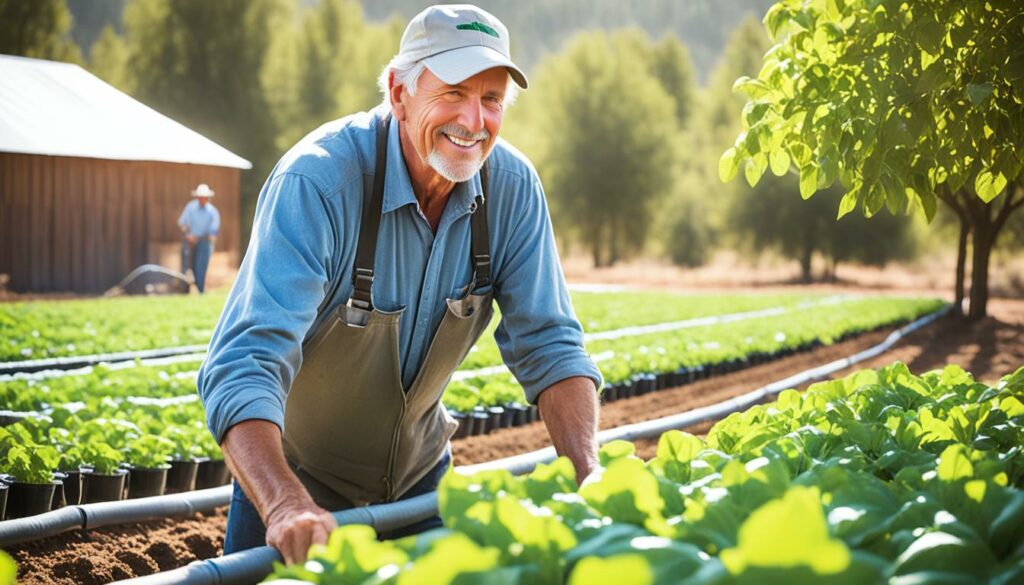
Mulching is about putting natural or man-made materials on the soil. It keeps moisture in and slows drying. Materials like straw or compost break down, feeding the soil and making it better.
Conservation tillage means less digging in the soil. It leaves old crops on top, which helps keep moisture and improves the soil. It also cuts down on erosion and runoff, making it good for saving moisture.
Planting cover crops, such as annual rye or clover, helps keep the soil moist. They cover the ground, blocking sunlight and reducing water loss. Cover crops make the soil healthier, stop erosion, and support sustainable farming.
| Technique | Benefits | Challenges |
|---|---|---|
| Mulching | Reduces evaporation, adds nutrients, improves soil structure | Sourcing sufficient organic materials |
| Conservation Tillage | Enhances soil organic matter, reduces erosion and runoff | Initial investment in equipment |
| Cover Crops | Reduces evaporation, adds organic matter, prevents erosion | Requires knowledge of suitable crops |
Using these techniques helps hold onto water and supports lasting farming. This is very important in places where water is getting scarcer because of climate change.
Advanced irrigation methods are key in using water better in farming. These include systems like drip irrigation and sprinklers. They also use high-tech planning and auto systems.
Drip systems water plants’ roots directly. This cuts water loss from evaporation and runoff. Each plant gets the right amount of water, saving water and making irrigation better. It’s worth noting that in the 2023 Colorado TAPS, top farmers used drip systems for great results.
Sprinklers are good for big plant areas. They can be set to turn on and off by themselves, spreading water evenly. This use of technology helps save water in a smart way.
Using set schedules and auto features in irrigation can save a lot of water. They have weather-based controllers and soil sensors. These systems give crops just the right water, exactly when needed. They need to fit strict rules to be sure they work well.
These systems remember their settings even without power. They can water differently in different areas. Plus, they alert the user if they’re not working as they should.
“Advanced irrigation strategies, such as those employed by the top teams in the 2023 Colorado TAPS program, underscore the significance of integrating technological advancements in irrigation for optimised water conservation and increased yield efficiency.”
For big areas, knowing the site well and considering the need for multiple systems is vital. Plus, having accurate weather info and good sensors makes these methods work better.
| Strategy | Advantages | Considerations |
|---|---|---|
| Drip Irrigation | Minimises water loss, delivers precise water amounts to roots | Initial setup cost, requires maintenance |
| Sprinkler Systems | Suitable for large areas, can be automated | Efficiency depends on weather conditions, potential for water waste |
| Scheduling & Automation | Optimises water usage, adapts to real-time data | Requires reliable sensor data, potential technological issues |
Getting accurate soil moisture readings is key for saving water and farming precisely. High-tech tools help farmers decide when to water, increasing crop quality and using resources better. Time domain reflectometry, capacitance sensors, and gravimetric methods are some important tools.
Time domain reflectometry (TDR) uses short electromagnetic pulses to check soil moisture. It’s known for being very accurate and trusted by farmers doing precision work. TDR works by sending a pulse through a probe in the soil and then checking how fast it comes back. This tells farmers the moisture, helping them water right when crops need it.
Capacitance sensors look at how well soil holds moisture to guess how wet it is. They are great because they give updates all the time, supporting efforts to save water. By checking how soil reacts to electricity, these sensors give farmers important information. This helps them use water more wisely.
To find out how much water is in soil, gravimetric methods require taking soil samples and drying them out. Though it takes a lot of work, this way is very accurate and sets the standard for other methods. Because it’s so precise, this test is used to make sure other tools are working right. This helps farmers trust other technology to water their fields properly.
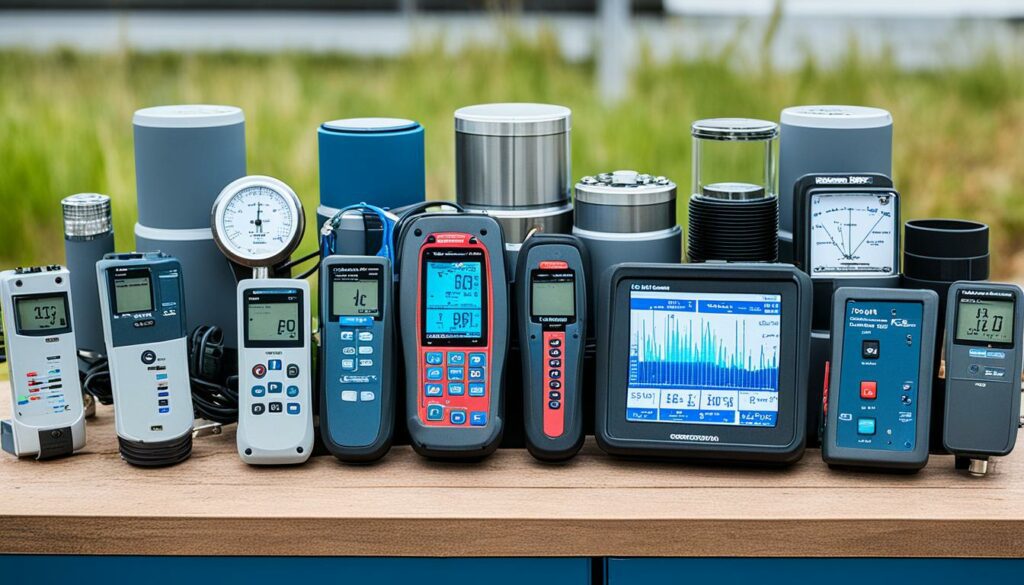
In Missouri, technology like the MU Extension network and the Crop Water Use app assist in smart farming. This includes electronic weather stations and a calculation app. They work together with soil moisture sensors to give farmers the facts they need for watering. This can help farmers use water well and save more.
Even old methods, like the charts made by Dr. C.M. “Woody” Woodruff in the 1960s, are still helpful. These charts work with new tools to blend old farming knowledge with up-to-date technology. This mix helps in taking care of land in a better, lasting way.
| Method | Technology | Key Feature |
|---|---|---|
| Time Domain Reflectometry | Electromagnetic Pulses | Real-time Data |
| Capacitance Sensors | Dielectric Permittivity | Continuous Monitoring |
| Gravimetric Methods | Oven-Drying Samples | High Accuracy |
Soil moisture management faces big hurdles that affect farming a lot. They’re due to climate change, soil getting too tightly packed, and how fast water evaporates. Knowing these problems helps us find ways to keep soil moisture just right.
Adapting to climate change is key in today’s farming world. This change leads to unpredictable rain and more dry spells. In places like the tropics, farming without extra water is hit hard. To fight this, capturing rain better and keeping the soil wet deeply are important.
Big machines compacting the soil makes it harder for water to sink in and flow. This leaves less room for plants to find water. Less water getting in harms the farm, making crops grow less and causing more water to run off. That’s why we need to use less heavy machines and till the soil less.
| Factors | Impacts | Solutions |
|---|---|---|
| Soil Compaction | Less water getting in, plants get less water, crops produce less | Do less tilling, use lighter machines |
| Climate Change | Rain comes unexpectedly, soil moisture hard to control | Get rainwater in soil better, keep soil moist |
Evaporation plus plants sweating out water dries the soil out fast. This affects plant growth and how much food we can grow. To slow this drying, use techniques like adding a layer of mulch and planting cover crops.
So, fighting climate change, fixing soil compaction, and tackling drying out are vital for making soil moisture work well in farming. With smart tools like SenseCAP S2104 and S2105 to watch over the soil, and by using smart methods, we make farms stronger and more productive.
Keeping water in the soil is vital, especially in areas with tropical and subtropical rainfed farming. About three-quarters of the world’s farmlands have this issue. It makes it really important to use water wisely. The yearly rain in these places varies from 400 to 1000 mm. So, it’s key to find ways to better keep water in the ground.
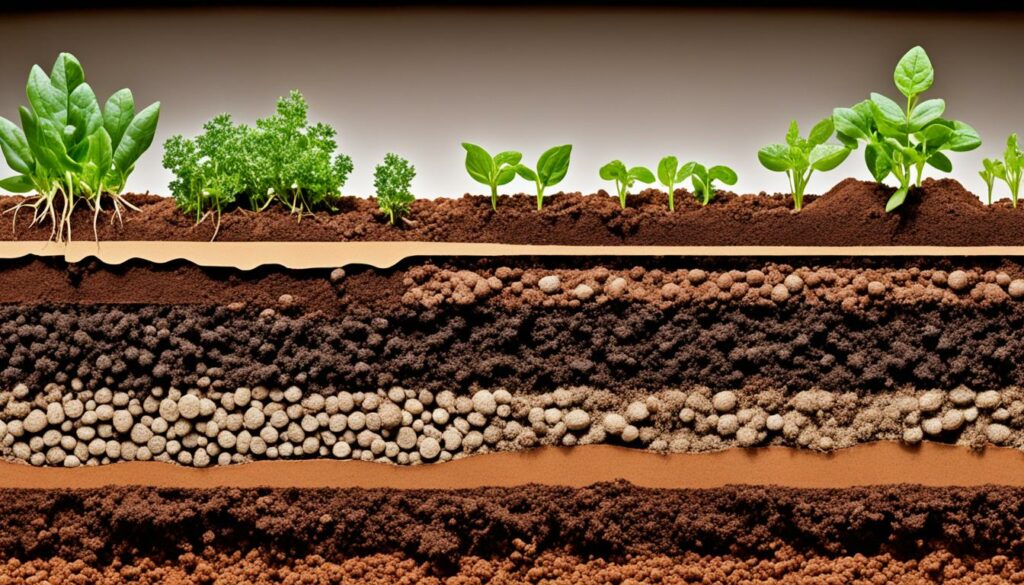
Soil type, how deep it is, how much organic stuff it has, and the life in it affect how well it holds water. Doing less digging can help a lot. It lets water sink in and stay in the ground better. Good soil structure helps water go down fast. Badly structured soil makes water run off the surface. Managing soil well stops water waste, which helps plants get more water.
Things like compost and peat moss make the soil hold water better. They work like sponges, soaking up water and slowly giving it to plants. Other materials, like vermiculite and perlite, also help by keeping water in the soil. Using these can make farming cheaper by needing less water.
Soil getting squashed by machines makes it hard for water to go in. This is a big problem. It’s really important to avoid squashing the soil. And, knowing how rainwater moves through the soil is also key. This understanding helps in using rain and the soil’s water well.
Using stuff in the soil to keep water better has many benefits. It makes water use smarter and reduces the risk of soil washing away. By doing this, farming becomes more sustainable. It can handle bad weather better.
| Factors | Impact on Soil Moisture Retention |
|---|---|
| Soil Texture and Structure | Influences the rate of water infiltration and retention. |
| Organic Matter Content | Enhances water-holding capacity and slow release of moisture. |
| Soil Compaction | Reduces infiltration rates, leads to runoff and water loss. |
| Hydrological Cycle | Understanding is crucial for managing rainfall and soil water. |
| Soil Additives | Improve water retention, reduce water consumption, and minimise erosion. |
Organic matter helps a lot with how soil holds water. It does this by making the soil better at holding water. This is if you add things like manure and compost to it. These things make the soil healthier. So, plants can get the water they need without extra watering.
Organic matter and temperature change how much soil ‘breathes’ in oak forests. This breathing is what makes soil healthy. When there is more organic stuff in the ground, it makes moisture management a lot better. This is good because it means plants in places like forests can grow better.
Dead leaves and roots are important in keeping soil moist and healthy. In really old forests, these natural materials help keep more water in the ground. They also help the soil ‘breathe’ better. When this happens, it’s easier for plants to grow strong and healthy.
Even a little more organic matter in the soil can hold a lot more water. Just a 1% increase in organic matter means thousands of gallons more water the soil can hold. This shows how important organic matter is for managing water well.
This is true in all kinds of soil, from loamy sand to clay. More organic matter means the soil keeps more water. This stops water from running off instead of soaking into the ground.
| Soil Type | Increase in Available Water Capacity (Gallons) per 1% Increase in Organic Matter |
|---|---|
| Loamy Sand | From 32,583 to 36,249 |
| Silt Loam | From 71,682 to 75,075 |
| Clay Loam | From 55,391 to 58,056 |
Scientists also found that organic matter affects soil in different ways. It helps with keeping the soil moist and helps soil life grow. This makes it easier to manage moisture in the soil. And that’s really important for making sure plants can thrive.
Case studies are now key in showing how to manage soil moisture well. They focus on both drought management and keeping moisture in check in rainy areas. This helps farmers improve their harvests.
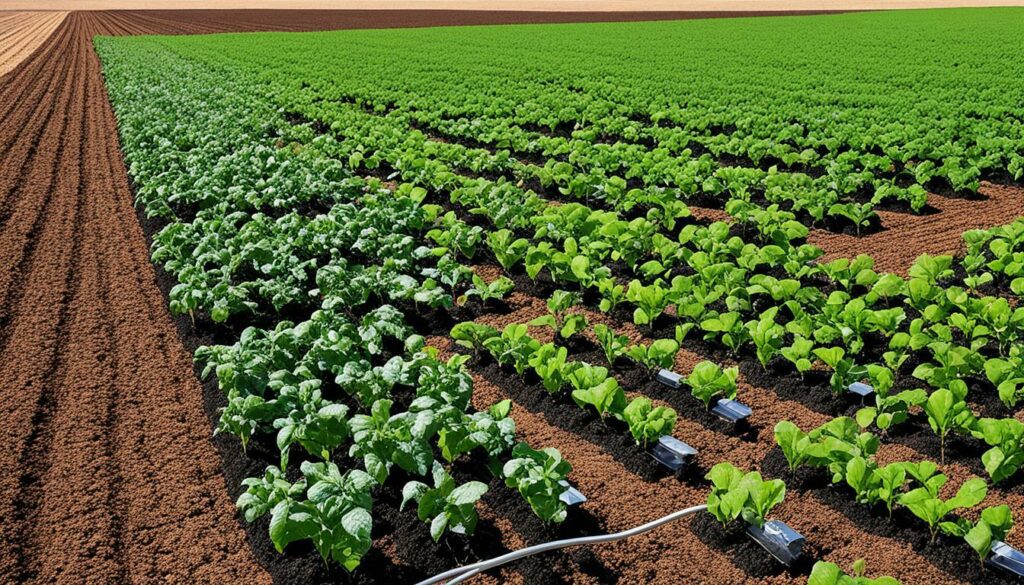
Places that often face droughts need careful soil moisture handling. The American Farmland Trust (AFT) used a 2018 USDA grant to study this. They talked to farmers and found ways like better tillage to keep the soil moist.
Lots of rain can also damage crops. AFT looked into how farms in New York deal with too much water. They wanted to see if good soil practices can work without losing money.
More research is happening to learn even more. Every year, the DFBS survey adds new insights. This work explores the link between healthy soil and making a profit.
Looking after the soil well is key to handling water runoff. This keeps the ground strong and the water clean. Through good planning, we can change how water moves and stays in farm soils. This is big for making the most out of rain and getting better crops.
Stopping soil from washing away keeps it rich and productive. One method is contour ploughing. It helps slow down water by ploughing in line with the land’s slopes. This cuts how much topsoil is lost in heavy rain. Strip cropping also helps by planting different crops next to each other. It defends the soil and boosts its nutrients.
Sound soil care also boosts our water underground. By covering soil with plants or mulch, it stops rain from packing and flowing freely. This way, more water sinks into the ground to reach deeper levels. Mulching with things like jujube branches really cuts the water rushing off and lets more soak in.
Managing soil moisture well brings many economic benefits for farmers. By keeping the right amount of moisture in the soil, they can slash their irrigation costs. This makes their farm more economically efficient.
One key aid for farmers is the American Farmland Trust (AFT)’s R-SHEC Tool. It’s made for those who grow crops in rows and almonds. This tool checks the costs and wins of using soil-friendly methods. It shows lower irrigation costs and other savings from better soil health.
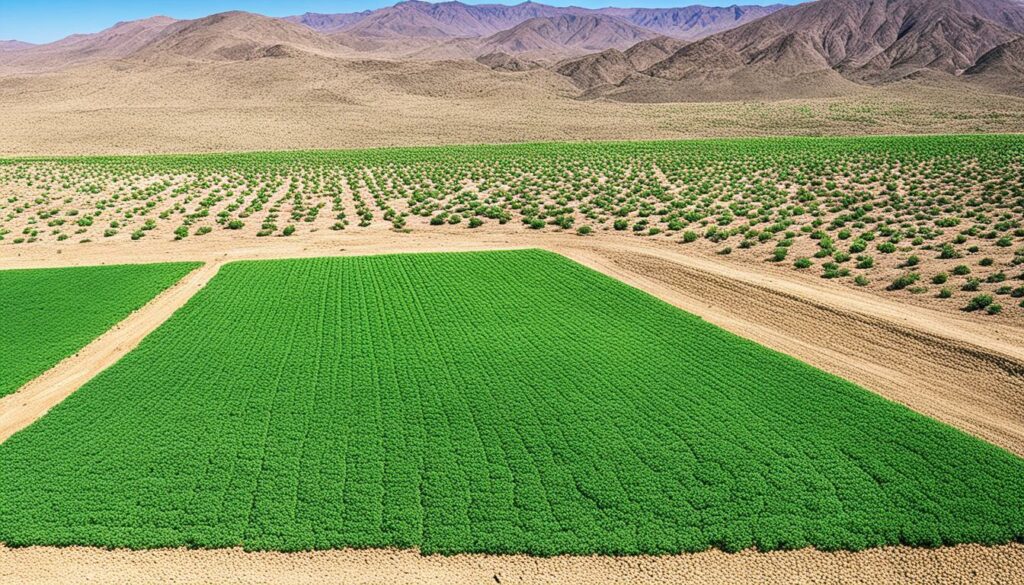
Using these smart techniques can boost how much crops make. When farmers use techniques that keep soil healthy, funded by grants including the USDA’s, they get more crops. This also means better quality food. With increased crop yields, it’s a win for their wallets over time.
Also important is the Soil Health Case Study Tool Kit, which is free to use. It gives farmers tools, materials, and guides to follow. These help them put the best practices into action. As a result, they get more crops and save money. The kit shows a clear way to keep getting good results from looking after the soil’s moisture.
Looking after soil moisture well has huge environmental benefits. It helps manage resources like water better. This improves the soil’s health. Saving and using soil moisture well means we need less extra water. This eases the pressure on our water sources.
Managing soil well cuts down on soil damage. It fights soil erosion and stops nutrients from washing away. This keeps the soil rich and helps crops grow better.
Soil moisture conservation also helps keep the land diverse. By keeping the soil in good shape and adding natural materials, many living things thrive. This includes tiny microorganisms and animals. They keep the whole ecosystem balanced.
Our changing climate is a big problem, but we can become more resistant with good soil moisture care. It makes the soil hold water better. Thus, it helps plants survive dry periods.
Using tech like moisture sensors is also good for resource management. These tools offer up-to-the-minute data. This means we can water plants exactly when they need it. This stops us from wasting water.
To sum up, here’s a table showing what good soil moisture management can do for different environmental areas:
| Environmental Factor | Without Proper Management | With Proper Management |
|---|---|---|
| Water Usage | High | Optimised |
| Soil Erosion | Severe | Reduced |
| Biodiversity | Limited | Promoted |
| Soil Health | Degraded | Enhanced |
In dryland areas, where water is short, using smart strategies is key. For example, rainwater harvesting and contour ploughing are vital. They help save water, make soil better, and increase crop yields.
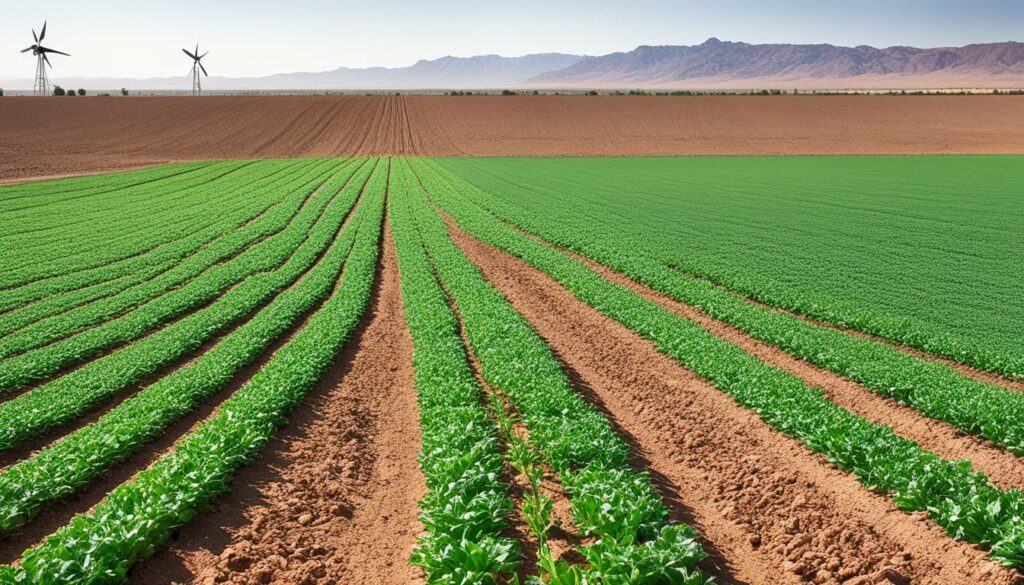
Rainwater harvesting means saving rain for later when it’s dry. By saving water, farmers can keep their crops watered even in dry spells. This is really helpful where it only rains at certain times.
Using stored rainwater means plants get water when they need it. This makes crops grow better and lowers the risk of them dying in a drought.
Contour ploughing is a key method in dryland farming. It matches the natural lay of the land. This helps stop water running off and keeps the soil in place. By doing this, the soil holds more water.
When you plough this way, it’s easier for plants to get water. This means they’re likely to grow more. Plus, it keeps the soil healthy, which is important for farming over the long term.
These methods really help manage the land better in dry places. They can make a big difference in how much farmers can grow.
Managing soil moisture well is vital for soil health. We need to use methods that keep nutrients in balance and increase biodiversity. This helps our farms be more durable and productive. Let’s look at how we can make this work:
Good nutrient management is crucial. Things like changing crops each season and adding natural materials are key. These actions keep nutrients in check. It also makes soil hold water better.
But, using machines to till the soil a lot, without adding natural materials, can hurt the soil. This makes it harder for water to soak in, which means plants don’t grow well.
Having a lot of different life in the soil helps it stay healthy. This includes using cover crops and adding a layer of dead plants (mulch). They stop the wind and rain from taking the soil away. This also makes the soil hold onto water well.
Having many different plants and animals involved makes tiny life in the soil (microbes) thrive. Having these little creatures is good for the soil and helps it hold onto water. It also helps keep harmful bugs away and supports better farming.
Many soils around the world are not in good shape – about 30%. This shows we need to act fast. Both governments and farmers must team up. Together, they need to find ways to look after the soil better. This means using methods that are good for the soil in the long run.
To make the best use of water, boost farm yields, and keep the environment healthy, a good soil moisture plan is key. For example, maize needs around 90-95% of water at the start but less as it grows. This prevents big drops in how much maize we get. Good soil moisture stops plants from getting too much or too little water at different stages.
New tech companies, like Rivulis, offer smart ways to irrigate your fields. Their sensors give you data in real-time. This info helps farmers know exactly what each crop needs. Together with advice from experts, farmers can make decisions that fit the water needs of their crops.
Using these modern methods alongside tried-and-tested advice supports a healthy, forward-looking farming industry. By staying informed and balanced, farmers can meet the challenges of changing weather head-on. This mix of saving water, smart irrigation, and careful monitoring makes farm work more effective. It helps keep farms running smoothly for the future.
Soil moisture is vital for crops. It helps them grow well by providing enough water through transpiration. It ensures there is water stored for later needs or to help groundwater.
This stops rainwater being lost through runoff or evaporation. This boosts how much crops grow and their quality.
Great soil moisture leads to better crop yields. It makes better use of rain and improves the soil’s water content where roots are. This gives more produce, saves groundwater, and lessens losses during dry times.
Understanding soil water movement includes looking at how water enters and moves through soil. What’s on the soil’s surface and how it’s treated affect this. The type of soil and how deep it goes also play a part.
Rainfall and the type of soil affect how much moisture is in the ground. The way the soil is made and how plants grow also matter. These aspects influence where water goes and how plants can reach it.
Ways to save soil moisture include mulching, special types of ploughing, and using certain plants. Mulching keeps water in by covering the ground. Less ploughing means the soil structure stays strong and can take in more water. Certain plants can also shield the ground from the sun, helping to keep water inside.
Drip irrigation, sprinklers, and smart technology are used in advanced farming. Drip systems send water where it’s most needed, saving water. Sprinklers can cover big areas and work automatically. Timing irrigation to when it’s best for the plants makes water use efficient.
Tools like time domain reflectometry and sensors accurately measure soil moisture. They use different methods, like sending electromagnetic pulses into the ground. This information is used to water the plants just right.
Dealing with changing climates and compacted soil is hard. Farming machinery can squash the soil, making it harder for water to get in. Managing plant and ground water loss is key to not losing too much water.
Keeping water in the soil means looking after how it’s structured and what’s in it. Not tilling the soil much can stop water from rushing off the land. It keeps water where the plants can use it. Adding things like mulch and plant leftovers can also help keep water around.
Organic matter is a big help in letting soil hold onto water. Things like manure and compost improve the soil’s ability to keep and provide water for plants. This means less time with irrigation, saving water and money.
Yes, there are examples of doing well in dry and wet places. Using rain cleverly and choosing the right crops can help store and spread water in the ground. This can make farming last through the dry spells and have more food to sell.
Good soil care can cut how much water runs off and keep the ground from wearing away. By ploughing with the land’s shape and planting in rows, water moves slower and doesn’t wash the soil away. This lets more water sink in and helps the farm stay moist.
Managing soil water well can lower the need for lots of water and help the plants make more food. This means better crops and bigger profits for the farmer.
The right care for soil moisture cuts down on extra water use and helps nature stay healthy. It keeps the soil from getting worse and supports many kinds of plants and animals. This is good for the planet, stopping some of the bad effects of too much farming.
Places with not much rain can still farm well by saving water and stopping the soil from drying out. One way is to collect rainwater and spread straw or plant leftovers on the ground. This keeps more water and helps the plants survive.
By keeping the soil rich and varied, it holds onto water better. Crop changing and adding natural things to the soil make a living system. This supports plant growth and uses water well.